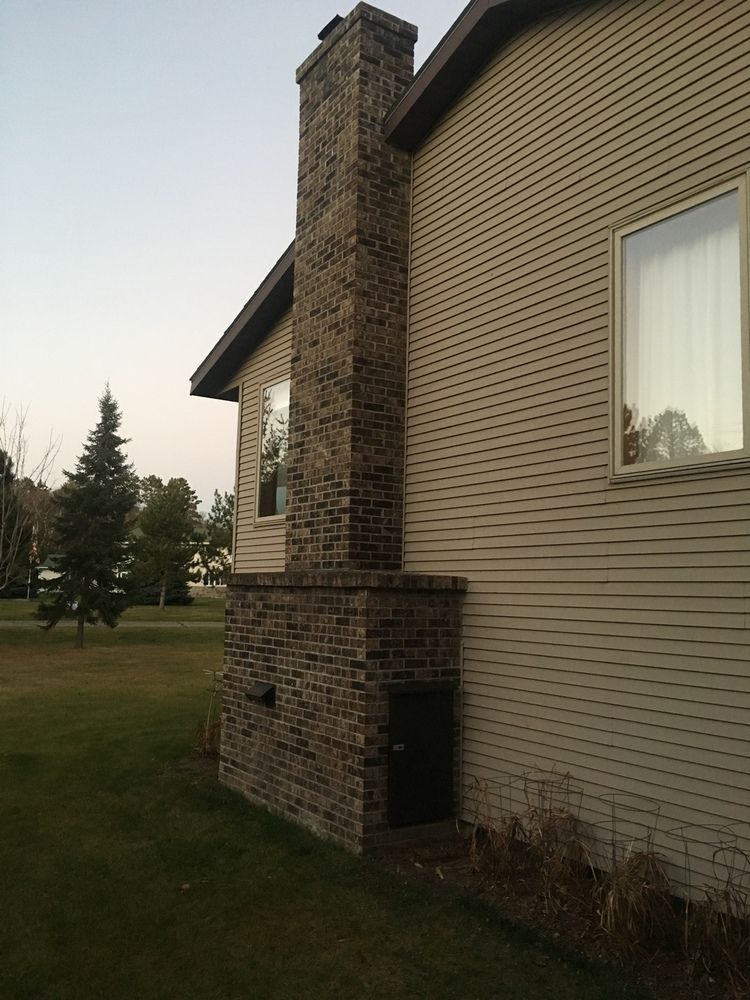While the old Security Chimneys BIS is doing fine, my ultimate goal is to install a free-standing woodstove that will give us more heat and less worry. We didn't build this house, so I've been discovering things about it over the past 6 months we've lived here. The plan is to be here another 9-10 years, so I'd love to get this new stove installed next year, if possible.
I thought the chimney was masonry (clay-lined) all the way up, but I think that's not true now. You can see in the photos that there is a 9" (7" inner diameter) chimney coming out the top of the fireplace. I assumed it switched to a clay flue after going through the concrete "cap" at the top of the brick "box". However, now I realize it's probably insulated almost all the way up. The top of the chimney has a 7" square clay opening, surrounded by a mortar dome. Actually, there are two clay openings, but one is mortared closed. When I look down the top of the chimney, I see about 2 feet down that the flue changes to something round. I assume that is the top of the insulated steel chimney.
So here's the question. I want to rip out the ZC fireplace completely, which will leave me with an alcove situation, I believe. The current fireplace is elevated on a block-supported hearth, but the chimney "box" goes all the way down to basement floor level (overall height of chimney box is a bit over 8 feet, I figure). I assume that when I pull the BIS out, the metal chimney isn't just going to fall down...but I guess it might. I also assume that would leave me with an "open" masonry chimney within which I could run a new liner. I'd probably have to re-do the chimney cap to replace the mortar dome with a steel box and cap, supporting the new liner.
Does anyone have experience with upgrading this sort of installation? What else will I need to consider (aside from which stove to buy). I plan to completely re-do the hearth and pull the stone facade off the wall. I'd then build a new rock/stone-veneered alcove opening the entire height of the basement wall.
I thought the chimney was masonry (clay-lined) all the way up, but I think that's not true now. You can see in the photos that there is a 9" (7" inner diameter) chimney coming out the top of the fireplace. I assumed it switched to a clay flue after going through the concrete "cap" at the top of the brick "box". However, now I realize it's probably insulated almost all the way up. The top of the chimney has a 7" square clay opening, surrounded by a mortar dome. Actually, there are two clay openings, but one is mortared closed. When I look down the top of the chimney, I see about 2 feet down that the flue changes to something round. I assume that is the top of the insulated steel chimney.
So here's the question. I want to rip out the ZC fireplace completely, which will leave me with an alcove situation, I believe. The current fireplace is elevated on a block-supported hearth, but the chimney "box" goes all the way down to basement floor level (overall height of chimney box is a bit over 8 feet, I figure). I assume that when I pull the BIS out, the metal chimney isn't just going to fall down...but I guess it might. I also assume that would leave me with an "open" masonry chimney within which I could run a new liner. I'd probably have to re-do the chimney cap to replace the mortar dome with a steel box and cap, supporting the new liner.
Does anyone have experience with upgrading this sort of installation? What else will I need to consider (aside from which stove to buy). I plan to completely re-do the hearth and pull the stone facade off the wall. I'd then build a new rock/stone-veneered alcove opening the entire height of the basement wall.






![[Hearth.com] Planning stages - replacing a ZC fireplace. [Hearth.com] Planning stages - replacing a ZC fireplace.](https://www.hearth.com/talk/data/attachments/189/189337-cb143ef09cca7ba581d226591108fe16.jpg?hash=hj0QFH2l8a)

![[Hearth.com] Planning stages - replacing a ZC fireplace. [Hearth.com] Planning stages - replacing a ZC fireplace.](https://www.hearth.com/talk/data/attachments/190/190167-0a70d051481681f99986ec22daa52c7a.jpg?hash=_s-YD_yDDx)
![[Hearth.com] Planning stages - replacing a ZC fireplace. [Hearth.com] Planning stages - replacing a ZC fireplace.](https://www.hearth.com/talk/data/attachments/193/193748-338025b9e7360d7853de2938afe2fc6f.jpg?hash=TIwlEUT2CT)
![[Hearth.com] Planning stages - replacing a ZC fireplace. [Hearth.com] Planning stages - replacing a ZC fireplace.](https://www.hearth.com/talk/data/attachments/197/197177-4b89101d1f7a00122c803f6d8fde84a6.jpg?hash=EQoZmrptZr)
![[Hearth.com] Planning stages - replacing a ZC fireplace. [Hearth.com] Planning stages - replacing a ZC fireplace.](https://www.hearth.com/talk/data/attachments/197/197247-e0374f07e07c2cb70d205891efde42fb.jpg?hash=sWmBrzdC6z)
![[Hearth.com] Planning stages - replacing a ZC fireplace. [Hearth.com] Planning stages - replacing a ZC fireplace.](https://www.hearth.com/talk/data/attachments/197/197284-fad9c2bbd7b71100cb8c3ac0e0ebc6fc.jpg?hash=bXpwkvXEth)
![[Hearth.com] Planning stages - replacing a ZC fireplace. [Hearth.com] Planning stages - replacing a ZC fireplace.](https://www.hearth.com/talk/data/attachments/197/197577-192a8c42a4fbf9286d07a1f5dac84a1f.jpg?hash=mrs7Hw4bRI)
![[Hearth.com] Planning stages - replacing a ZC fireplace. [Hearth.com] Planning stages - replacing a ZC fireplace.](https://www.hearth.com/talk/data/attachments/197/197620-fd11d47072be7b071ce3bba52235b997.jpg?hash=-FQVQ_vMj_)
![[Hearth.com] Planning stages - replacing a ZC fireplace. [Hearth.com] Planning stages - replacing a ZC fireplace.](https://www.hearth.com/talk/data/attachments/197/197621-bf61cbee9b831d0083d47ba9636f43de.jpg?hash=55e24SOIjB)
![[Hearth.com] Planning stages - replacing a ZC fireplace. [Hearth.com] Planning stages - replacing a ZC fireplace.](https://www.hearth.com/talk/data/attachments/197/197710-9417106312cdaa1b71bd331c1f1bb1d3.jpg?hash=adVcp4l2bb)
![[Hearth.com] Planning stages - replacing a ZC fireplace. [Hearth.com] Planning stages - replacing a ZC fireplace.](https://www.hearth.com/talk/data/attachments/198/198043-262df93f747a166876602b1274e957c2.jpg?hash=ecylw8Vqfk)
![[Hearth.com] Planning stages - replacing a ZC fireplace. [Hearth.com] Planning stages - replacing a ZC fireplace.](https://www.hearth.com/talk/data/attachments/198/198134-9d2fadac335d22ea2366e4d237e111f9.jpg?hash=UtRQasn1dQ)